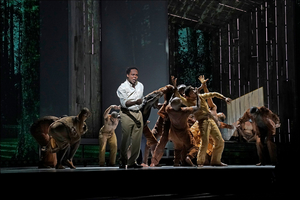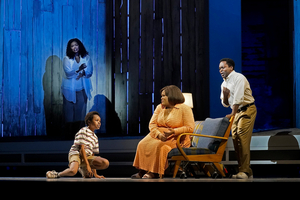Review: Blanchard's FIRE SHUT UP IN MY BONES Opens Met Season with Fireworks
Company’s First Opera by a Black Composer Has Audience on Its Feet

sequence. Photo: Ken Howard/Met Opera
It's been a long 18 months since the last opera on the Met's stage. The Terence Blanchard-Kasi Lemmons FIRE SHUT UP IN MY BONES roared into Lincoln Center to let the audience know what it has been missing. And not just from the company.
But by (finally!) presenting its first work by a Black composer, it showed that the music by an overlooked segment of the arts community. It reminded us, once again, that there's more to lyric theatre than AIDA, BOHEME and CARMEN--that a composer, and librettist, doesn't have to come out of the archives to get things right. The score, rich in lyricism as well as jazz and gospel, was acutely memorable, but the words brought it crisply into focus, as it told a story that was filled with details from beginning to end.
The emotion of the work, in both music and words, and spectacular choreography, couldn't help but reach the hearts of everyone in attendance and eventually brought them to their feet, cheering the cast and creators. Co-directors James Robinson (from St. Louis, where the opera had its debut at the Opera Theatre of St. Louis) and Camille Brown, who was also the spectacular choreographer, deserve kudos for helping bring this poignant yet hopeful piece to life.
Set designer Allen Moyer, working with projections by Greg Emetaz and lighting by Christopher Akerlind, made sure that the cinematically moving production never fell back to stock answers to the hard questions being posed. Paul Tazewell's costumes brought life in rural Louisiana into focus.

Will Liverman. Photo: Ken Howard/Met Opera
The opera is based on a memoir by a New York Times columnist, Charles Blow, about his life and times as a sensitive child (boy soprano Walter Russell III, outstanding as Char'es Baby, a difficult role) growing up in rural Louisiana, how he lived through tough times, including sexual molestation, and came out the other side (Will Liverman as the adult Charles, who took some time for his sensual baritone to bloom) through his own resources and the love of his mother, Billie (the magnificent soprano, Latonia Moore).
By showing Charles as both child and man, the creators showed how he never lost the degradation that he had suffered as a child. At the same time, the older version of the character could have learned things from his younger self that he couldn't come up with on his own, but didn't seem to want to hear. The two singing actors brilliantly played off one another, a perfectly matched pair.
In some ways, the opera belonged to Charles' mother. Billie had much of Blanchard's best music, dramatic, lyrical with touches of the composer's jazz background. As she held her son's life together, in some ways she was the cornerstone of the opera. Her presence was a rock that he could rely on, whether supporting the family, or, in the end, a shoulder he could lean on as he finally shared the abuse that he had survived at the hands of his cousin, Chester (the chameleon-like baritone Chris Kenney in his house debut).
In a trio of roles, the marvelous soprano Angel Blue was another key to the evolution of Charles from boy to man. First as Destiny then as Loneliness, two of the major forces in the growing character. Finally, she was Greta, his first love (who might as well have been called Disappointment) who was already taken when he met her (though he didn't know it) and misled him into thinking he could finally find happiness in his life.
Other standouts in the cast were bass-baritone Ryan Speedo Green, as the sympathetic Uncle Paul, and tenor Chauncey Packer as Spinner, Charles' womanizing father. And, of course, the Met's first-rate chorus put in another of its stellar performances, under Donald Palumbo.
The Met's orchestra, under Music Director Yannick Nezet-Seguin, was in fine form, bringing out every detail and style in Blanchard's complex score.
As I mentioned earlier, co-Director Camille Brown was also choreographer of the piece and she did amazing work, in particular in the dream/nightmare sequence for burgeoning adult in Charles and the long (perhaps too long, though the audience cheered) step-dance scene that started Act III, which stopped the performance cold, as the house went wild.
Was it perfect? No: Some sequences went on too long and perhaps some of the orchestration was too lush for the down-home story, sometimes the stage seemed to swallow up the intimate narrative. But in the end, it really didn't matter-certainly not in the hands of the stellar cast, the chorus, dancers and orchestral musicians who were part of this momentous occasion.
You have to see this for yourself.
There are seven more performances at the Met, with the final matinee part of the company's "Live in HD" series, on October 23 at 1 pm. For more information, see the Met's website.
Reader Reviews
Videos

